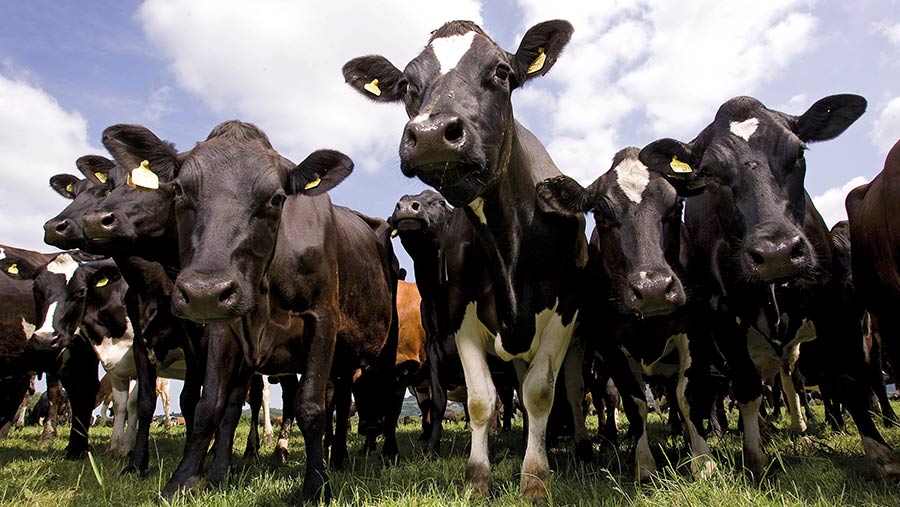Livestock sector can cut emissions by 23%, says report
 © Jonathan Page
© Jonathan Page Greenhouse gas emissions (GHGs) from agriculture can be cut by 23% across all main livestock types if widescale, science-backed mitigations are adopted across UK farms.
This is according to the findings of the latest report from the Centre for Innovation Excellence in Livestock (Ciel).
Titled Net Zero & Livestock: How Farmers Can Reduce Emissions, the report follows Ciel’s 2020 report Net Zero Carbon & UK Livestock, which set out emission benchmarks for a range of farming systems and livestock enterprises.
The aim of the most recent publication is to provide both farmers and the wider supply chain with science-driven, evidence-based information to help them make better decisions about livestock production and net zero.
Ciel chief executive Lyndsay Chapman told the recent launch event that it followed demand by Ciel members for further research in this area,
See also: Farmer group sets out practical guide to net zero future
Ms Chapman said the latest report took the research one step further, giving farmers an insight into the practical solutions and mitigations which could help them reduce their carbon footprint and associated emissions.
Research team
The research was carried out by a consortium of scientists appointed by Ciel, from the Agri-Food and Biosciences Institute (AFBI), Queen’s University Belfast, Scotland’s Rural College (SRUC) and Rothamsted Research.
They looked at the five key livestock species – dairy, beef, sheep, pigs and poultry – and explored the potential options for each to reduce emissions.
They then assessed how easy and cost-effective these options would be to implement, modelling them on real-life case studies to show how they might work on a practical scale.
The research team also looked at measuring and monitoring these mitigations and emissions. To do this, they compared carbon calculators with the UK National Inventory.
Inventory accounting, via the National Inventory, is the tool used by the government to measure farm emissions and set national net-zero targets. It also forms the basis of international climate change treaties.
An example of an intervention for beef and dairy cows is to feed diets low in crude protein. These have the potential to lower methane and nitrous oxide emissions.
Another is to focus on genetic improvement in pigs. This would be a low-cost, easy-to-implement mitigation which could also help bring down methane and nitrous oxide emissions associated with pork production.
Elizabeth Magowan, director of the sustainable agri-food sciences division at AFBI, said: “[The report] is a very complex topic, but what we have tried to do through the research is provide useful and meaningful information to help people understand what is possible and also where the challenges remain.”
Main findings
Headline findings include:
- Ruminants represent about 73% of total GHGs from agriculture and 52% of ammonia emissions overall, while pig and poultry equate to 5% of GHGs from agriculture and 20% of ammonia emissions (see “Emissions from agriculture”)
- There is national potential for a 23% reduction in greenhouse gas emissions (across all sectors) – but this is based on 100% uptake and ambitious estimates of efficacy
- Methane inhibitors have considerable potential, but there are still big challenges to their adoption into UK grazing systems and a lot more work is needed
- Improving efficiency across all sectors is fundamental for reducing the environmental impact of farming
- Verification of the efficacy of the proposed mitigations is needed for them to be adopted to the National Inventory
- There is no one silver bullet – reaching net zero is going to require a range of solutions
- Carbon sequestration is a low-cost GHG mitigation, but there is a lot of uncertainty surrounding it. There is a significant gap in knowledge about carbon sequestration under grassland, which needs to be addressed urgently.
Next steps
Mark Young, head of innovation at Ciel, said monitoring and measuring carbon needed to be done now to enable livestock producers to act on the results.
“The results from carbon calculators will be even better if you are putting in good performance data and other metrics from your farm,” he said. “We need to ensure we are recording data and using it effectively to get a good feel for the carbon footprint of the farm.”
Dr Young reinforced the report’s conclusion that no single action would deliver the net-zero ambition. Rather, multiple interventions would be needed, but this was likely to take place over a period of time, and some mitigations – such as technologies – were not quite ready for commercial adoption.
However, he said the most cost-efficient and effective ways to make gains on farm right now were:
- Focus on efficiency – adopt measures that also increase profit
- Exploit new technologies as they become available
- Use farm carbon calculators – these are essential as they define standard features and reward good practice
- Collaborate across sectors – delivering change requires a collective effort.
Emissions from agriculture |
||||
|
|
Ammonia |
Nitrous oxide |
Methane |
Greenhouse gases (carbon dioxide equivalent) |
|
Dairy |
27% |
12% |
38% |
29% |
|
Beef |
20% |
16% |
40% |
32% |
|
Sheep |
5% |
3% |
17% |
12% |
|
Pig |
8% |
4% |
3% |
3% |
|
Poultry |
14% |
5% |
0% |
2% |
| Source: Elizabeth Magowan/UK National Inventory 2019 data | ||||
In the coming weeks Farmers Weekly will be exploring in detail the potential mitigation solutions from the report for the dairy, beef, sheep, pig and poultry sectors.
